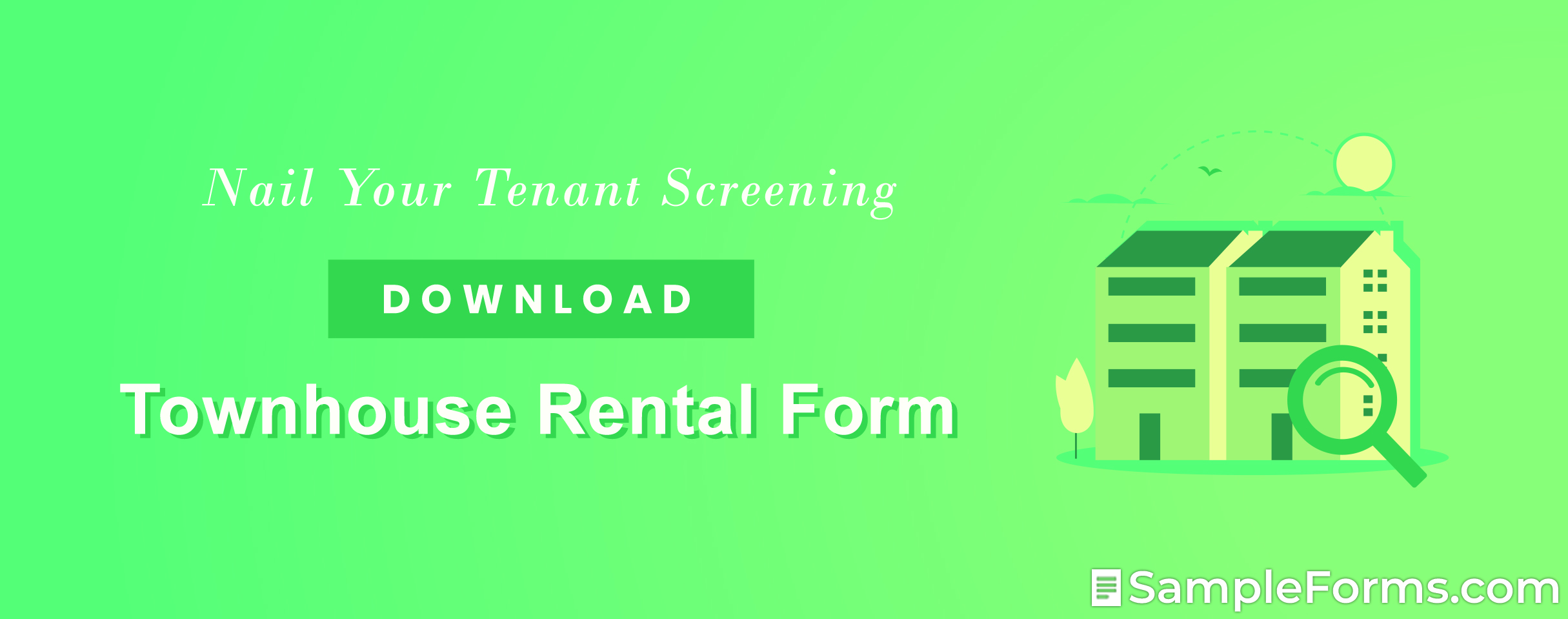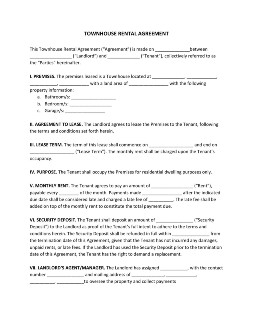- Eviction Notice Forms
- Power of Attorney Forms Forms
- Bill of Sale (Purchase Agreement) Forms
- Lease Agreement Forms
- Rental Application Forms
- Living Will Forms Forms
- Recommendation Letters Forms
- Resignation Letters Forms
- Release of Liability Agreement Forms
- Promissory Note Forms
- LLC Operating Agreement Forms
- Deed of Sale Forms
- Consent Form Forms
- Support Affidavit Forms
- Paternity Affidavit Forms
- Marital Affidavit Forms
- Financial Affidavit Forms
- Residential Affidavit Forms
- Affidavit of Identity Forms
- Affidavit of Title Forms
- Employment Affidavit Forms
- Affidavit of Loss Forms
- Gift Affidavit Forms
- Small Estate Affidavit Forms
- Service Affidavit Forms
- Heirship Affidavit Forms
- Survivorship Affidavit Forms
- Desistance Affidavit Forms
- Discrepancy Affidavit Forms
- Guardianship Affidavit Forms
- Undertaking Affidavit Forms
- General Affidavit Forms
- Affidavit of Death Forms
Townhouse Rental Form
Renting is an ideal choice for nonlocals who are working far away from home and college students studying outside their hometown. Renting is also the logical choice for short-term living, and like many businesses, landlords have their own terms and conditions on how the arrangement will work during the entirety of the agreement. If you are looking for tips on how to create a legally binding contract, you’ve come to the right place. This article provides an informative guide on creating Townhouse Rental Forms. Read More
What Is a Townhouse Rental Form?

A townhouse rental agreement is a written agreement between the landlord and the tenant regarding the rental of a townhouse. The form consists of the stipulations that the landlord requires from the tenant. Among the most vital stipulations found in this agreement are the names and the mailing addresses of both parties, starting and ending dates, the property’s description, and the payment terms.
According to iProperty Management, in 2019, a total of 44 million Americans rented their homes. 15% of these were 65 or older, 22% were below 30, 30% were between the ages of 45 and 64, while 33% were between 30 and 44. Although a substantial massive chunk of their paychecks go to the monthly rent and renting has been proven to be more expensive than buying a home. Still, these people are opting to rent because of its zero maintenance fees, flexibility, cheaper utilities, lower cost of insurance, among other things.
How to Write a Townhouse Rental Form?
Your agreement should be an all-encompassing document with no room for qualms. Below, we have collected the most instructional tips to get you started.
1. Familiarize Yourself with State Laws
Familiarize yourself with the State laws before you can start crafting your agreement. Matters regarding the collection of security deposits, grace periods, notices, collection of monthly rent are some of the things you should consider.
2. Determine the Lease Term
Discuss the possible lease terms that you can offer your tenant. This lease term may either be fixed or on a month-to-month basis. Discuss their preferences and set rules that they may never change their lease term once they sign the agreement.
3. Specify Both Parties
In your agreement, it’s essential to identify both parties that are involved. Label the landlord and the tenant in your agreement along with the mailing addresses. Your names must match the names in your identification cards, birth certificates, and other relevant documents.
4. Include the Property Description
The property description must include the square meters of the property, number of bedrooms, bathrooms, inclusions such as utilities and appliances, number of garages, etc. Ensure a complete legal description of the premises to avoid having a similar description to your other properties. The legal description of your property can be found in your County Register, land title, property tax assessments, mortgage contract, and current or previous deeds.
5. Include All Stipulations That You Demand
Even with the number of tenants on your premises, you’d still want the same tranquillity and order also when the premises have been rented. Be specific and descriptive about these stipulations and their corresponding remedies. Don’t forget to include the termination and default clause. Take note that your requirements should still comply with the State laws.
6. Consult with a Lawyer
Contracts and agreements, ideally, should be left in the hands of the lawyer. But since the information is easily handed to us digitally, it’s easier to craft our agreement. It’s a good idea to consult with your lawyer to check for any loopholes that the tenant may use to their advantage.
Once the lawyer is satisfied with your agreement, you are now ready to sign the deal with the tenant. A witness should also be physically present to certify your identities, attest to your consent, and sign the document. You may keep the original copy and provide a copy for the tenant as well.
Frequently Asked Questions
Should a lawyer write my townhouse rental agreement?
You don’t need a lawyer to write your townhouse rental agreement—as long as they are aligned with your State laws, you’re good to go. Although, it doesn’t hurt to consult your lawyer after making the agreement for your security.
What should be included in a rental agreement?
According to My Smart Move, it should have the names of the tenants and the property description, the tenancy’s duration or lease term, limited list of occupants, rent stipulations, fees and deposits, move-in paperwork, repairs and maintenance, and house rules.
Should I have my rental agreement notarized?
It depends. If the rental agreement is less than 12 months, you don’t have to notarize your rental agreement. Although a notarized document is not mandatory, it is heavily advised. A notarized agreement is more effective than a non-notarized one.
What happens if I should break the lease?
If you break the lease before the end of the term, you might be liable to pay for the damages. However, the conditions differ from landlord to landlord—you may read the agreement for stipulations regarding the early termination of the lease. The security deposit may not be used for last month’s rent unless authorized by the landlord.
Who gets to keep the original copy of the rental agreement?
Ideally, it is the landlord who keeps the original copy of the rental agreement. In some cases, the landlord keeps the original copy while the tenant is given an extra copy of it. But, both parties may be provided with original copies.

